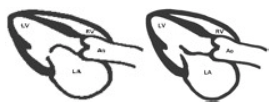11.4 Echocardiographic Findings in Mitral Stenosis
11.4.1 The mitral valve
The hallmark of mitral stenosis is "doming of the anterior mitral valve leaflet". The leaflet bulges towards the left ventricle because blood is "caught" in the leaflet (similar to a sail in the wind). Doming is caused by commissural fusion and reduction of the mitral valve opening area. This is best seen on a parasternal long-axis view. The degree of doming depends not only on the severity of mitral stenosis but also on the mobility of the anterior mitral valve leaflet. When the leaflet is calcified or severely thickened and therefore "stiff", it will demonstrate mild or even no doming. Since leaflet thickening progresses with age, doming is less frequently encountered in the elderly.
Patients with thickened and calcified valves display less or no doming The opening snap heard during auscultation is caused by doming of the anterior leaflet Parasternal long axis view in a patient with mitral stenosis and doming of the AMVL Parasternal long axis view of a normal mitral valve without domingThe posterior leaflet typically mirrors the motion of the anterior leaflet and moves anteriorly together with the anterior leaflet during diastole - a phenomenon which can be displayed with the MMode and has previously been used as a diagnostic criterion for mitral stenosis.
Calcified rheumatic mitral stenosis with no doming
In rheumatic stenosis one often finds postinflammatory alterations, such as retracted and restricted leaflets, calcific deposits, or chordal rupture. Thickening is predominantly seen in the leaflet tips, but may also be present in the entire mitral valve. Very frequently one will note subvalvular involvement with thickened and fused chordae. When subvalvular involvement is very prominent, stenosis will become more "funnular".

When assessing the mitral valve it is important to use several views, especially the apical long-axis view which best displays the subvalvular apparatus, and a parasternal short-axis view at the level of the mitral valve to demonstrate commissural fusion and the opening motion of the mitral valve.
11.4.2 Other valves
Rheumatic heart disease may also affect other valves, the pericardium and the myocardium. Furthermore, the hemodynamic sequelae of mitral stenosis alter the function and morphology of the heart. Therefore, assessment of mitral stenosis should include all aspects of the disease.
There is a high prevalence of aortic valve involvement in rheumatic disease. One frequently finds mild degrees of aortic stenosis (which may progress as the patient grows older), and particularly aortic regurgitation. Thickening of the aortic valve is predominantly seen in the free edges of the cusps. Calcified deposits are observed in many cases.
Aortic valve involvement in rheumatic heart disease. The aortic valve is thickened and aortic regurgitation is present. Note the patient also has rheumatic mitral regurgitation. Almost 2/3 of patients with mitral stenosis also show moderate or severe aortic regurgitation and some patients also develop aortic stenosis. Approximately 40% of patients with rheumatic mitral stenosis have moderate or severe mitral regurgitationThe tricuspid valve is frequently incompetent, either as a result of annular dilatation or in the presence of rheumatic tricuspid valve stenosis. In latter one would find tricuspid valve doming and at least some degree of tricuspid valve inflow obstruction.

11.4.3 The heart chambers
Typically patients with isolated mitral stenosis will have a rather small left ventricle because left ventricular filling is impaired. Left ventricular function is usually normal, as the left ventricle is overloaded neither in terms of pressure nor in terms of volume. When left ventricular function is reduced, rheumatic myocardial involvement must be taken into account.
A dilated left ventricle in the setting of mitral stenosis is often indicative of volume overload caused by additional mitral- or aortic regurgitation.Chronic pressure overload of the left atrium leads to left atrial dilatation. However, the size of the atria not only depends on the severity of stenosis but also on the compliance of the left atrium and the presence of atrial fibrillation and/or mitral regurgitation. Further signs of elevated left atrial pressure are the presence of a dilated/expanded left atrial appendage and bulging of the interatrial septum towards the right.
The size of the left atrium can not be used to assess the severity of mitral stenosis, other factors also play a role (i.e. left atrial compliance, atrial fibrillation, mitral regurgitation). Because left atrial pressure is much higher than normal even small defects of the interatrial septum (patent foramen ovale or atrial septal defects can lead to significant left to right shuntingThe right atrium is frequently dilated as well, either due to the presence of tricuspid regurgitation, pulmonary hypertension, or both. Right ventricular enlargement may be the result of pulmonary hypertension and / or tricuspid regurgitation. Pulmonary hypertension is a frequent finding in mitral stenosis. It correlates well with the patient's symptoms and the severity of mitral stenosis.
11.4.4 Mitral stenosis and thrombus formation

Mitral stenosis predisposes to left atrial thrombus formation. The incidence of systemic embolism in untreated patients is high (10-20%) There are two main reasons why patients with mitral stenosis develop thrombi: First, blood flow within the enlarged left atrium is slow and second many patients with mitral stenosis have atrial fibrillation which leads to contractile dysfunction of the atria
Four chamber view of a patient with mitral stenosis, an enlarged left atrium and a left atrial thrombus Risk of Thrombus in mitral stenosis Systemic embolism occurs in 20% of all MS patients 80% of with patients with thrombi have Afib 45% have spontaneous left atrial contrastWith 2D - echo you will often see spontaneous contrast in the left atria. This finding is also termed slow flow phenomena since it corresponds to the presence of slow blood flow. The presence of spontaneous contrast increases the likelihood of thrombus formation and is often seen in combination with thrombi. Most thrombi are found in the left atrial appendage. Since transthoracic echo is not ideal to visualize the appendage it is easy to miss a thrombus.
Most thrombi are seen in the left atrial appendage. These are often missed with transthoracic echocardiography Thrombus in the left atrial appendage in a patient with mitral stenosis, also note the presence of spontaneous contrast. Echocardiographic fndings in mitral stenosis LA enlargement Dilated pulmonic veins Small LV (in the absence of LV volume overload) Tricuspid regurgitation Pulmonary hypertension Thrombus